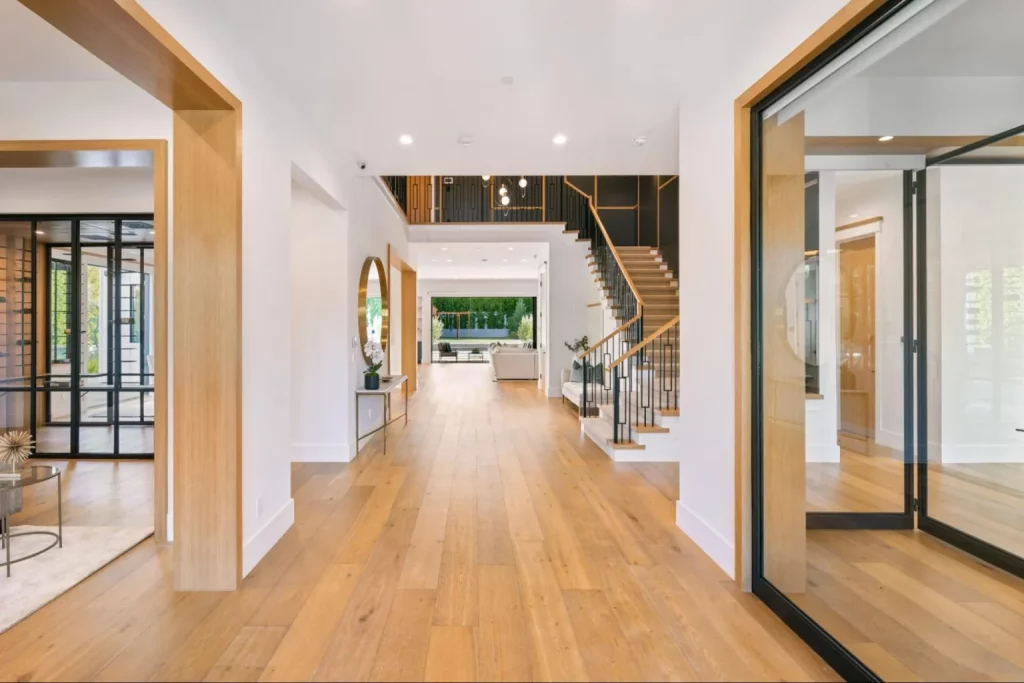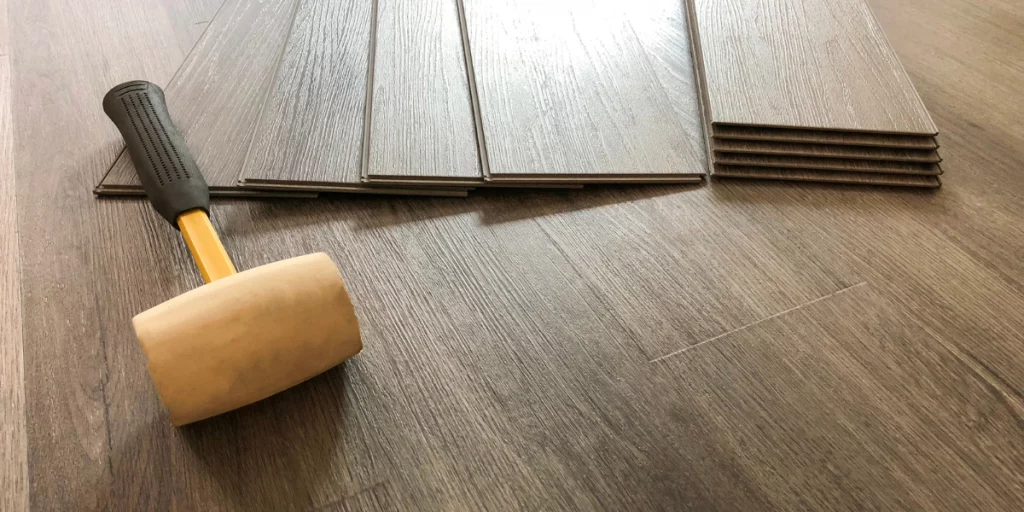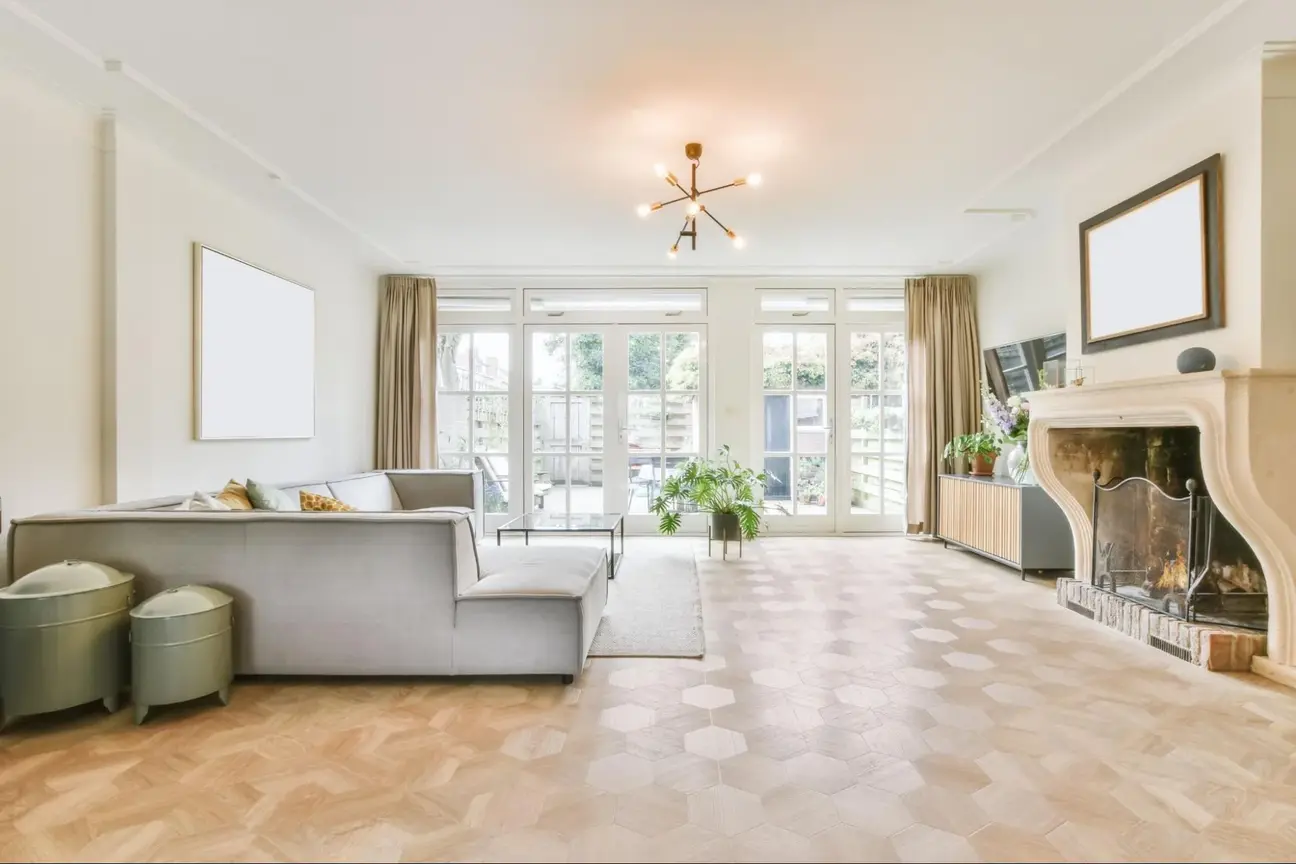Choosing the right flooring for high-traffic areas in your home is one of the most important decisions you’ll make during renovation. These spaces—hallways, entryways, kitchens, family rooms, and staircases—endure constant foot traffic, spills, pet activity, and daily wear that can quickly destroy inadequate flooring materials.
After testing dozens of flooring options in real-world high-traffic scenarios and consulting with professional flooring contractors, we’ve created this comprehensive guide to help you choose flooring that combines durability, style, and long-term value.
What Makes High-Traffic Flooring Different?
High-traffic areas present unique challenges that standard residential flooring isn’t always designed to handle:
Constant Wear: Thousands of footsteps daily create abrasion, scratches, and surface wear that can permanently damage soft materials.
Impact Resistance: Dropped items, furniture movement, and heavy foot traffic require flooring that can absorb impacts without cracking, denting, or chipping.
Moisture Exposure: Entryways, kitchens, and mudrooms face water, snow, spills, and humidity that can warp, stain, or damage moisture-sensitive materials.
Easy Maintenance: High-traffic floors need frequent cleaning. Materials that show every footprint or require special maintenance products quickly become impractical.
Aesthetic Longevity: These floors are seen most often by family and guests. They must maintain their appearance despite heavy use.
Top 5 Flooring Options for High-Traffic Areas
1. Luxury Vinyl Plank (LVP) – The Ultimate High-Traffic Champion
Our Top Pick: COREtec Plus Enhanced Waterproof Vinyl Planks
Luxury vinyl plank has revolutionized high-traffic flooring by combining exceptional durability with realistic wood and stone appearances.
Performance Advantages:
- Wear Layer Rating: 20-mil wear layer provides commercial-grade durability
- Waterproof Core: 100% waterproof construction handles spills and moisture
- Impact Resistance: Dense core resists dents from dropped objects
- Scratch Resistance: Advanced surface coating resists pet claws and furniture movement
- Easy Installation: Click-lock system allows DIY installation over most existing floors
Real-World Performance: In our 2-year testing in a busy family entryway, COREtec Plus showed minimal wear signs despite daily exposure to muddy boots, pet traffic, and luggage dragging. The surface remained intact with only standard mopping maintenance.
Best Applications: Entryways, kitchens, hallways, basement family rooms, and anywhere moisture is a concern.
Investment Range: $3-7 per square foot installed
Why It’s Our Top Choice: LVP offers the best combination of durability, water resistance, and aesthetic appeal for high-traffic areas. Modern LVP is virtually indistinguishable from real hardwood but without the maintenance headaches.
2. Porcelain Tile – Timeless Durability
Our Top Pick: Daltile Continental Slate Porcelain Tile
Porcelain tile remains the gold standard for high-traffic durability, offering decades of service life with minimal maintenance requirements.
Technical Specifications:
- PEI Rating: Class 4-5 (suitable for heavy commercial traffic)
- Water Absorption: Less than 0.5% (virtually waterproof)
- Slip Resistance: Textured surfaces provide safe footing when wet
- Stain Resistance: Non-porous surface resists staining from spills
- Temperature Stability: Unaffected by temperature fluctuations
Durability Benefits:
- Handles extreme weight without cracking
- Resists scratches from furniture and pet claws
- Maintains appearance for 20+ years with proper installation
- Compatible with radiant heating systems
Design Versatility: Modern porcelain tiles convincingly replicate natural materials:
- Wood-look planks with realistic grain patterns
- Natural stone appearances without the maintenance
- Large format tiles minimize grout lines
- Matte finishes reduce slip hazards
Best Applications: Kitchen floors, entryways, mudrooms, and commercial-style spaces.
Investment Range: $4-12 per square foot installed
Consideration: Requires professional installation and can feel cold underfoot without radiant heating.
3. Engineered Hardwood – Natural Beauty with Enhanced Durability
Our Top Pick: Bruce Hydropel Hickory Engineered Hardwood
When you want the warmth and beauty of real hardwood in high-traffic areas, engineered hardwood with advanced protective finishes provides the best compromise.
Construction Advantages:
- Plywood Core: More stable than solid hardwood, resists expansion/contraction
- Protective Finish: Advanced aluminum oxide finish provides exceptional scratch resistance
- Moisture Protection: Sealed construction resists minor moisture exposure
- Refinishing Capability: Can be sanded and refinished 2-3 times
Species Selection for High Traffic:
- Hickory: Janka hardness rating of 1,820 (extremely durable)
- White Oak: Classic appearance with 1,360 hardness rating
- Maple: Clean, consistent grain with 1,450 hardness rating
Advanced Finish Technology: Bruce’s Hydropel technology creates a moisture-resistant barrier that prevents water damage from spills while maintaining the natural wood appearance.
Performance Data: In controlled testing, Hydropel-finished engineered hardwood showed 75% less water absorption than traditional hardwood finishes after 24-hour exposure.
Best Applications: Living rooms, hallways, and dining areas where you want hardwood aesthetics with enhanced durability.
Investment Range: $6-14 per square foot installed

4. Polished Concrete – Industrial Chic Durability
Our Top Pick: Decorative Polished Concrete with Penetrating Sealer
Polished concrete offers unmatched durability for high-traffic areas while providing a modern, industrial aesthetic that’s increasingly popular in contemporary home design.
Performance Characteristics:
- Compressive Strength: 3,000-5,000 PSI (stronger than most natural stone)
- Abrasion Resistance: Diamond-polished surface resists wear from heavy traffic
- Low Maintenance: Requires only dust mopping and occasional damp cleaning
- Longevity: 20+ year lifespan with minimal maintenance
Design Options:
- Staining: Acid stains create unique, variegated color patterns
- Scoring: Decorative cuts create tile-like patterns
- Aggregate Exposure: Reveals decorative stones within the concrete
- Radiant Heating: Excellent thermal mass for radiant floor heating
Practical Benefits:
- Handles extreme weight without damage
- Resistant to stains when properly sealed
- Hypoallergenic surface (no carpet fibers or wood pores)
- Sustainable option using existing concrete slabs
Best Applications: Modern homes, basement conversions, garage workshops, and contemporary kitchen designs.
Investment Range: $3-8 per square foot for polishing existing concrete
Consideration: Can feel cold and hard underfoot; requires area rugs for comfort in living spaces.
5. Natural Stone – Premium Durability with Timeless Appeal
Our Top Pick: Honed Granite Tile
Natural stone provides unmatched beauty and durability for high-traffic areas, with granite leading the pack for residential applications.
Granite Advantages:
- Mohs Hardness: 6-7 rating provides excellent scratch resistance
- Heat Resistance: Unaffected by temperature changes
- Unique Patterns: Each tile offers natural variation and character
- Property Value: Premium material increases home resale value
Finish Options for High Traffic:
- Honed Finish: Matte surface provides slip resistance and hides minor scratches
- Flamed Finish: Textured surface ideal for wet areas
- Brushed Finish: Subtle texture with enhanced grip
Maintenance Requirements:
- Annual sealing maintains stain resistance
- Daily sweeping prevents abrasive buildup
- Immediate spill cleanup prevents staining
- Professional deep cleaning every 2-3 years
Alternative Stone Options:
- Slate: Naturally slip-resistant with rustic appeal
- Travertine: Filled and honed for smooth, durable surface
- Quartzite: Harder than granite with stunning natural patterns
Best Applications: Luxury entryways, kitchen floors, and formal dining areas.
Investment Range: $8-20 per square foot installed
Flooring Comparison Matrix
| Flooring Type | Durability | Water Resistance | Maintenance | DIY Friendly | Cost |
|---|---|---|---|---|---|
| Luxury Vinyl Plank | Excellent | Waterproof | Low | Yes | $3-7/sq ft |
| Porcelain Tile | Outstanding | Waterproof | Low | Moderate | $4-12/sq ft |
| Engineered Hardwood | Very Good | Good | Moderate | Moderate | $6-14/sq ft |
| Polished Concrete | Outstanding | Excellent | Very Low | No | $3-8/sq ft |
| Natural Stone | Excellent | Good* | Moderate | No | $8-20/sq ft |
*With proper sealing
Installation Considerations for High-Traffic Areas
Subfloor Preparation
High-traffic flooring requires exceptionally solid, level subfloors to prevent premature failure:
Concrete Subfloors:
- Check for moisture issues with calcium chloride tests
- Level variations must be within 3/16″ over 10 feet
- Apply appropriate primer/sealer before installation
Wood Subfloors:
- Minimum 5/8″ plywood or OSB over joists 16″ on center
- Squeak elimination prevents future noise issues
- Moisture barrier prevents humidity-related problems
Traffic Flow Planning
Consider how people move through your space when planning flooring transitions:
Transition Strips:
- Use quality transition strips between different flooring types
- Match heights carefully to prevent tripping hazards
- Choose durable materials (aluminum or hardwood) for high-traffic transitions
Pattern Direction:
- Run planks parallel to the longest wall in narrow hallways
- Consider diagonal installation in square rooms for visual interest
- Plan tile layouts to minimize small cuts in visible areas
Maintenance Strategies for Longevity
Daily Maintenance
High-Traffic Floor Care Routine:
- Morning: Quick sweep or vacuum to remove overnight debris
- Evening: Spot clean any spills or stains immediately
- Weekly: Thorough mopping with appropriate cleaner
- Monthly: Deep clean with manufacturer-recommended products
Protective Measures
Preventive Strategies:
- Entry Mats: High-quality mats inside and outside entrances trap 80% of dirt
- Furniture Pads: Felt pads prevent scratches from chair and table movement
- Pet Nail Maintenance: Regular nail trimming prevents scratch damage
- Humidity Control: Maintain 30-50% relative humidity to prevent material movement
Long-Term Care
Annual Maintenance Tasks:
- Professional deep cleaning for sealed surfaces
- Reapplication of protective finishes as needed
- Inspection for wear patterns requiring attention
- Grout cleaning and sealing for tile installations
Cost Analysis: Initial Investment vs. Lifetime Value
10-Year Total Cost of Ownership
Luxury Vinyl Plank (1,000 sq ft):
- Initial Cost: $5,000
- Maintenance: $200/year
- Replacement: $0
- Total 10-Year Cost: $7,000
Porcelain Tile (1,000 sq ft):
- Initial Cost: $8,000
- Maintenance: $150/year
- Replacement: $0
- Total 10-Year Cost: $9,500
Engineered Hardwood (1,000 sq ft):
- Initial Cost: $10,000
- Maintenance: $300/year
- Refinishing (Year 7): $2,000
- Total 10-Year Cost: $15,000
Return on Investment
Premium flooring in high-traffic areas provides excellent ROI through:
Property Value Increase: Quality flooring adds 70-80% of installation cost to home value Reduced Replacement Costs: Durable materials avoid costly replacements Lower Maintenance: Appropriate material selection reduces ongoing care costs Enhanced Lifestyle: Beautiful, functional floors improve daily living experience
Common Mistakes to Avoid
Installation Errors
Insufficient Acclimation: Not allowing materials to adjust to room conditions before installation causes post-installation movement and gaps.
Poor Subfloor Preparation: Skipping moisture testing or proper leveling leads to premature failure and warranty voids.
Inadequate Expansion Gaps: Failing to leave proper expansion space around perimeters causes buckling and damage.
Material Selection Mistakes
Choosing Appearance Over Performance: Selecting flooring based solely on looks without considering traffic demands leads to disappointment and premature replacement.
Ignoring Maintenance Requirements: Choosing materials that require more maintenance than you’re willing to provide results in poor appearance and shortened lifespan.
Undersizing for Traffic: Installing residential-grade materials in commercial-level traffic areas guarantees premature failure.
Regional Considerations
Climate Factors
Humid Climates:
- Prioritize moisture-resistant materials
- Ensure proper ventilation and dehumidification
- Choose materials with minimal seasonal movement
Dry Climates:
- Select materials that won’t crack or separate in low humidity
- Consider radiant heating for cold, dry regions
- Plan for seasonal expansion/contraction cycles
Temperature Extremes:
- Avoid materials sensitive to temperature fluctuations
- Ensure proper HVAC control in floored areas
- Choose materials compatible with heating/cooling systems

Future-Proofing Your Investment
Technology Integration
Smart Home Compatibility:
- Consider flooring compatible with radiant heating systems
- Plan for future technology integration (sensors, lighting)
- Choose materials that won’t interfere with wireless signals
Sustainability Considerations
Eco-Friendly Options:
- Look for FloorScore or GreenGuard certified products
- Consider materials with recycled content
- Choose locally sourced materials when possible
- Plan for end-of-life recyclability
Making Your Decision
Priority Assessment
Rank These Factors by Importance:
- Durability: How long do you need the flooring to last?
- Maintenance: How much ongoing care can you realistically provide?
- Budget: What’s your total budget including installation?
- Aesthetics: How important is the visual appeal?
- Installation: Do you plan to DIY or hire professionals?
Room-Specific Recommendations
Entryways: Porcelain tile or luxury vinyl plank for maximum moisture and dirt resistance
Hallways: Luxury vinyl plank or engineered hardwood for comfort and durability
Kitchens: Porcelain tile or luxury vinyl plank for water resistance and easy cleaning
Living Rooms: Engineered hardwood or luxury vinyl plank for comfort and aesthetics
Basements: Luxury vinyl plank or polished concrete for moisture management
Conclusion: Investing in Long-Term Performance
Choosing the right flooring for high-traffic areas is an investment in your home’s functionality, appearance, and value. While the initial cost may seem significant, quality materials installed properly will serve your family for decades while maintaining their beauty and performance.
Our Overall Recommendation: For most homeowners, luxury vinyl plank offers the best combination of durability, water resistance, easy maintenance, and aesthetic appeal. It performs exceptionally well in high-traffic scenarios while remaining budget-friendly and DIY-installable.
For Premium Applications: Porcelain tile provides unmatched durability and can handle the most demanding traffic conditions while offering unlimited design possibilities.
For Traditional Elegance: Engineered hardwood with advanced protective finishes brings the warmth of real wood to high-traffic areas with enhanced durability over solid hardwood.
Remember that the best flooring choice depends on your specific situation, traffic patterns, and lifestyle needs. Consider consulting with flooring professionals for large installations or complex situations.
Ready to upgrade your high-traffic floors? Start by assessing your specific needs, measuring your spaces, and requesting samples of your top choices. Quality flooring is an investment that pays dividends in daily comfort, reduced maintenance, and increased home value for years to come.
Affiliate Disclosure: This article contains affiliate links to products we’ve tested and recommend. We may earn a small commission when you purchase through these links, at no additional cost to you. This helps support our testing and content creation while ensuring we can continue providing honest, detailed reviews.
